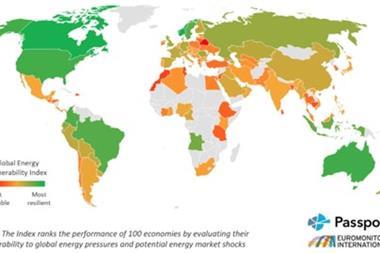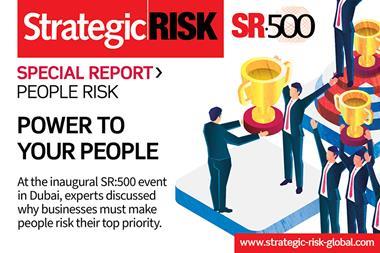RIMS, the acronym that stands for both the US Risk and Insurance Management Society and its eponymous conference, represents something very large. In fact, by comparison with European risk management conferences, the annual RIMS event is enormous. This year the San Diego conference centre played host to a record number of registered participants: 11,000 risk managers, exhibitors, sponsors, insurers, reinsurers, brokers, loss adjusters, press, RIMS staff and, undoubtedly, many others.
About 4,200 of those attending were risk managers. Nearly a quarter came from outside the US. There were 300 speakers. Competition for the risk managers' time and attention is intense, both inside and outside the conference centre. Former UK Prime Minister John Major spoke at a Marsh breakfast seminar; XL Capital hired SeaWorld for an evening party.
The vast exhibition hall contained 451 stands ranging in size from the architectural emplacements of carriers like AIG and brokers such as Aon to neat stalls for a single person. The lures for visitors were, as always, ingenious. There were all sorts of freebies: torches, pens, pads, twirley straws, miniature stuffed animals and plenty of large bags for all the give-aways from other stands. One claims solutions provider had an artist demonstrating a traditional Japanese art, creating hummingbirds, parrots, monkeys, foliage and all sorts of other animals out of nothing more than half solidified sugar.
Shoeshine, card tricks, instant magazine covers with visitors' faces, and business card draws to win an iPod, portable CD players, digital cameras and even a Harley Davidson were all there to try to capture a few minutes of the risk managers' time between meetings and conference sessions. If they were hungry or thirsty, popcorn, muffins, bagels, ice cream, coffee, juice, mineral water and chocolates were inducements for the risk manager to pause and talk. If they were weary, vibrating massage chairs offered instant relaxation.
The range of stands also displayed the wide ranging preoccupations of the US risk managers and support services. Amid all the insurance carriers, brokers, loss adjusters and solutions providers, this year safety footwear, such as shoes for loss adjusters to walk on roofs, was in evidence. The men at one such stand explained that the attractive, long-legged woman on a roof in their publicity shots was for real. When the company first started making the boots, it discovered that female loss adjusters needed special footwear, too, and it now does sizes down to three. Factual Photo Inc. Investigative service provides surveillance photos and other investigative services. Another stand promoted defibrillators for the work place.
As usual, the conference had only a few general sessions; James Schiro, CEO of Zurich Financial Services, gave the opening speech, Max Taylor, deputy chairman of Aon Limited and former chairman of Lloyd's was the keynote speaker. San Diego radio entertainer Glenn Erath was the draw for the final lunch. Much more extensive was the list of around 150 specialist sessions covering risk management in specific business sectors or cross-industry, ranging from the practical, to the conceptual, such as best corporate governance practices for tomorrow's boardroom.
From overseas
Despite this extensive - and for the newcomer probably overwhelming - number of ways to spend the day, not to mention dozens of open hospitality suites and private events in the evening, what made the long journey to San Diego worthwhile for European visitors was the chance to meet colleagues and business partners. Maurizio Castelli, group risk manager for Pirelli and chairman of the International Federation of Risk and Insurance Management Associations (IFRIMA), finds the greatest benefits of RIMS are the networking opportunities, often for meetings with other Europeans, and the exhibition.
With the vast choice of conference sessions, it is difficult to know which are the most suitable or pitched at the right level, so he spends about 70% of his time networking or in the exhibition. He says it is sometimes disappointing to find that a service that is just what he is looking for is only available in the US, but he was able to hire the risk manager for Pirelli's US operations using a specialist executive search agency that he first met thanks to RIMS.
Jean-Paul Rignault, CEO Axa Corporate Solutions, commented: "RIMS is useful because it gives a unique opportunity for all the parties in the business to meet. It is not just a way of getting general information about the main trends in the business, but you can actually discuss business and forge closer links with clients and potential clients."
Steve Fowler, executive director of the Institute of Risk Management (IRM) said: "I had an excellent meeting with risk management educators from around the world. There is a lot of potential for us to work together."
Another management educator, Jean-Paul Louisot from the French CARM Institute, said it takes time to learn how to get the best from such a large and extensive occasion, but by returning regularly the value increases exponentially.
"The best value is the networking, because you can meet a tremendous number of people and it gives an insight into where risk management is going, the developing issues."
AIRMIC executive director, David Gamble, was delighted with San Diego, describing it as one of the best locations and said he was pleased to see such a high attendance. What stood out? "It's difficult to say, as everyone sees it from their own interests, but it is a very professional, very well organised event which delivers quality to visitors."
To overseas
As well as attracting more international visitors to its main event, RIMS is looking to grow internationally. However, outgoing president Lance Ewing stressed that RIMS is not in competition with local risk management associations, even as it develops chapters and membership from outside the US, such as its new Mexican chapter in Monterey, which has 20 members.
Said Ewing: "RIMS continues to have a very positive relationship with other risk management organisations. There is no way we are in competition." Some local bodies do not have the resources and may not have people with the time and ability to travel, and RIMS as the largest risk management association in the world can provide support. Ewing, for example, has spoken on risk management in Croatia, Romania and Kosovo and has been invited to speak in Russia.
He added: "Another value of RIMS is that European and US risk managers can learn from each other. For instance, the UK is just getting the asbestos problems and now facing the same dilemmas that we have done. Litigation is an export that the US is happy to share with other countries, and we can share what we have learned." In September, RIMS is holding a symposium in London for US risk managers wanting a deeper understanding of the London market.
Globalisation has clearly come to risk management, but so far there are no plans for a giant, global risk management conference making a stately progress from one part of the world to another. IFRIMA last year decided to hold joint events with national or regional risk management associations.
The first one will take place in Bermuda from 7 to 10 September 2004 when the Latin American association ALARYS and IFRIMA have a joint meeting.
"We did not want to do another conference," said Castelli. "People feel there are already too many." Likewise, in 2005, the IFRIMA conference will be held in conjunction with the FERMA conference in Portugal and with the RIMS conference in Hawaii in 2007.
Reconstructing Iraq
By the end of April 2004, the US oil and gas service company Haliburton and its sub-contractors had lost 34 of their people in Iraq. Haliburton and its KBR subsidiary are one of the largest contractors servicing the US military and working on the country's reconstruction. At any one time, KBR has more than 700 trucks on Kuwaiti and Iraqi roads.
Not surprisingly, security and the need for it was the constant theme of the RIMS session 'Reconstructing Iraq'. It attracted an audience of about 30, of whom probably half a dozen were journalists. Of the remainder, about half said their companies were already involved in Iraq in some way or had bid for work there.
Chaired by Steve Sadler, a managing director of Marsh Inc. with contributions from Michael Lempres, vice president of insurance for the Overseas Private Investment Corporation (OPIC), and Peter White, deputy general manager, Marsh Inc., United Arab Emirates, the session was held against a background of growing concern for the safety of civilian contractors in Iraq.
Sadler advised: "Job site security is a big concern and you must have the cost of that security well articulated in any bid." There is no wholesale retreat by insurers from Iraq, but they make it clear that security is a requirement of the contract, and underwriters will want to see a plan, he explained.
The US Army Corps of Engineers (USACE) and US Navy are the primary agencies issuing contracts on behalf of the Coalition Provisional Authority Iraq Program Management Office (PMO), which is responsible for all Iraq reconstruction funded by the US government. The 1941 Defense Base Act (DBA) and later laws set out the levels of compensation that firms have to pay for workers' death or disability when they are working on contracts on military bases outside the US and on US government non-military infrastructure and security contracts.
Said Sadler: "DBA rates are very high, up to 30-33% of payroll. It depends on the worker. Reporters and media services are very highly rated. But for other contractors, it could be 6, 12, 15% of payroll." Kidnap and ransom cover is available, but the market is very small and he said such extensions are likely to be restricted to 'existing pet clients.' However, the majority of US casualties have been from motor vehicle accidents.
White added that DBA coverage is available through ACE, Chubb, CNA and AIG, but this is for people. It is much more difficult to insure assets.
The local insurance market had collapsed by the time of the Iraq invasion, and so far nothing has replaced it. There is currently no Iraqi insurance law, but the US Agency for International Development has appointed Arkansas insurance commissioner Mike Pickens and UK reinsurance specialist Mike Carr to draft a new one. A number of major insurers are said to be interested in entering the market.
INSURANCE PRICES TURN DOWNWARD
Commercial insurance buyers say the costs of two major lines of insurance fell in the first quarter of 2004, according to the RIMS Benchmark Survey of market conditions, released at the conference. In the first quarter of 2004, property insurance prices fell by about 1.5%. General liability insurance premiums also fell by 1.4%, marking the first time in over four years that prices for two major lines of insurance retreated in the same quarter. The cost of property insurance peaked in mid-2003 with prices down 8.8 % in the fourth quarter, the first reduction in premium prices for any major line of commercial insurance since 2000. Price increases in other lines of insurance continued to slow. Employment practices liability, crime and, most notably, directors' and officers' liability (D&O) all experienced rises of less than five per cent in the final quarter of last year.
QUALITIES OF SUCCESSFUL RISK MANAGERS
Successful risk managers in the US are experienced professionals most often with a post-graduate degree or professional qualification, a study sponsored by Marsh and RIMS and published at the annual RIMS conference in April 2004, revealed. The survey covered 30 risk managers who have received public recognition in their business role. Seventy per cent of the sample have more than 20 years experience in risk management, mainly as risk managers, but also in insurance, broking or other jobs. They tend to have uncommon stability in their employment, with the majority in their current firm for over 10 years.
Most risk management functions are slim with half having no more than five people - and sometimes none- reporting to them. The most common reporting line for the risk manager is to the treasurer, followed by the CFO. Four report directly to the CEO. These risk managers are well educated. All but three have studied at undergraduate level, 21 have first degrees and 27 post-graduate degrees. Despite this, almost all those surveyed mentioned a need for greater understanding of financial, accounting and tax issues.



















